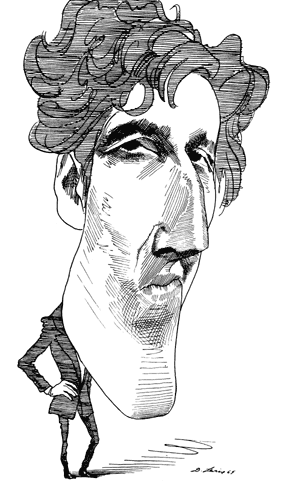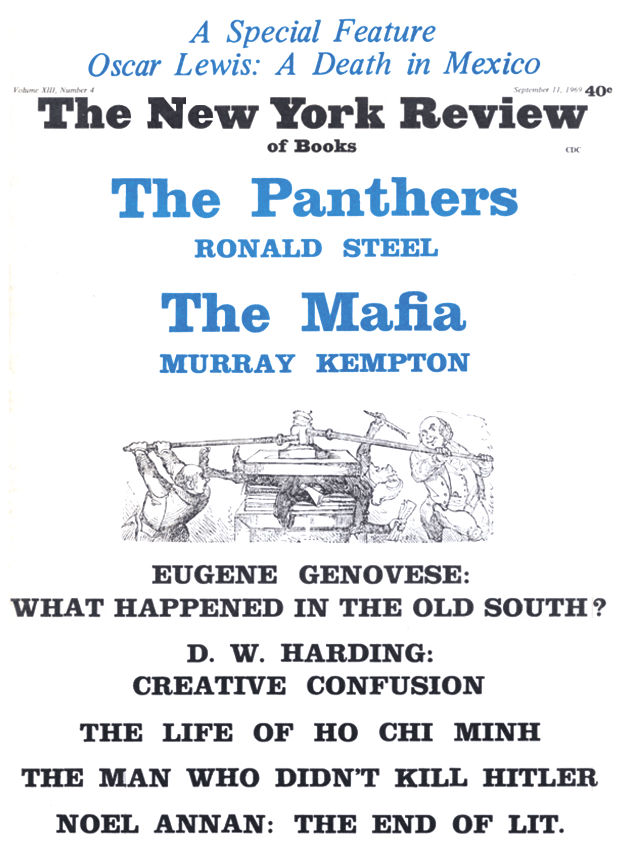“I suppose I’m getting squeamish! But this Ronald Firbank I can’t take to at all. Valmouth! Was there ever a novel more coarse? I assure you I hadn’t gone very far when I had to put it down.”
“It’s out,” Mrs. Bedley suavely said, “as well,” she added, “as the rest of them.”
“I once met him,” Miss Hopkins said, dilating slightly the retinae of her eyes. “He told me writing books was by no means easy!”
Mrs. Barleymoon shrugged.
—The Flower Beneath the Foot
Mrs. Bedley means that the book is out of the circulating library, but it seems that Firbank has been “out” recently, at least in the United States. Miss Benkovits notes in her bibliography that last year only two volumes were in print, neither of which included his masterpiece, Concerning the Eccentricities of Cardinal Pirelli. This can now be found in the reprinted New Directions collection (1949), together with The Flower Beneath the Foot, Prancing Nigger, Valmouth, and The Artificial Princess, with the old Introduction by the late Osbert Sitwell. The ladies’ comments have their point: Firbank is by no means a coarse writer, but all his books are full of delicate innuendo.
He was not always exact (instead of “retinae” he should, I think have put “pupillae“) but he was extremely painstaking. Miss Benkovits shows in her biography, which is itself painstaking, that Firbank did not find writing books easy, but was a highly dedicated artist. His little books were worked up slowly from notes, he searched endlessly for the right word and cut down drafts ruthlessly, to produce that economical dialogue from which Evelyn Waugh learned so much. He said he was all construction when he got going. His later work, which looks so casual, must be taken seriously as craftsmanship.
Firbank was the most fantastic of all English dandies and decadents, and became a mythical figure in his lifetime. Since he was excessively shy, elusive, and drunken, there are comparatively few records of his conversation, though many of his attenuated appearance. Most of the best are in Ifan Kyrle Fletcher’s memoir of 1930, which has pieces by Augustus John and other friends, and in Sitwell’s Introduction. These are, however, not always accurate, and have often had to be corrected by Miss Benkovits from her great knowledge of the documents. Disappointingly she has failed to add any story or fact that adds anything striking to one’s impression of Firbank. The best is an unpublished piece by Nancy Cunard, who describes him talking really well, in the last year of his life: “How consecutive he was. A new personality was revealed…. The effect of his conversation was as stimulating as the wind over rough cliff-grass…. It showed me the vitality of his being beneath all the ‘fantasia-fantasia.’ ”
The man evidently had a bottom of good sense. He also had a sound financial basis for his eccentric way of life: we learn that he had inherited at least £700 a year, which is probably the equivalent of $15,000 after taxes today. With this he could travel all the time, to Europe, North Africa, Cuba, keeping restlessly on the move, stopping in modest hotels and flats, but drinking champagne in the Café Royal when at home, blending his fragmentary sharp impressions into the topography, architecture, and characters of his imaginary worlds. I don’t see why Miss Benkovits should doubt the reality of his postcard to the Sitwells (“Tomorrow I go to Hayti. They say the President is a Perfect Dear!”) on the grounds that he never got to Haiti. He never got to Valmouth or Pisuerga either, and the Seville of Cardinal Pirelli is just as much an imaginary country as these, although he actually knew Seville well.
High Camp, of which Firbank is the outstanding exponent, is a branch of Camp, itself only one part of the homosexual subculture of modern society. This is a boring subject to outsiders when it is taken seriously or sentimentally, as by Angus Wilson or Isherwood; but it is a wonderful setting for comedy, as these authors have also proved. Camp is above all dramatic: it involves playing roles, dressing, transvestism, like the Dame’s in British pantomime, and fantasy. This element of play-drama seems to come into most kinds of sexual deviation, but because the laws and prejudices against homosexuality have driven it half underground, it has been associated with subterfuge and innuendo, which lead naturally to dramatic stratagems; and given the amount of maliciousness found in some homosexual temperaments (like Firbank’s) the name of the play is satirical comedy.
High, that is cultured, Camp has tended to look toward the most dramatic of all architectural and sculptural styles, the Baroque; and to the sacred drama and aesthetic charms of the Roman Catholic Church (Firbank was converted while at Cambridge but later fell away). High Camp also looks toward the Ideal Salon, where the people are so well bred that they will never say anything obvious, and know each other so intimately that they need never explain themselves: conversational wit lies in overtones and verbal gestures. All this is the stuff of Firbankian comedy, and nowhere is the mixture of Baroque description, absurd party talk, ecclesiastical haberdashery, jokes about choirboys, and self-parody found to better effect than in his posthumous Concerning the Eccentricities of Cardinal Pirelli.
Advertisement
In the first of a series of beautifully shaped scenes, each with its location and décor carefully placed, the Cardinal, an aging rake, is christening a police-dog, the pet of a grand lady. He is being spied on, and this and other irregularities are being reported to the Vatican. From the last remark of a ludicrous society party (a parody of Proust) we learn that he has fled the capital; later, the Pope Tertius the Second is seen to be vaguely distressed, murmuring “Why can’t they all behave?” In the last scene, the Cardinal hopelessly chases his one remaining choirboy through the deserted church, and as the last of his vestments slips off in the chase he dies of heart failure. The blending of learning and triviality throughout is perfect. It would be unFirbankian and pompous to call Pirelli a fable for our times; yet apart from his wonderful clowning, Firbank treats the theme of disorder and decay with melancholy Yeatsian grandeur:
The forsaken splendour of the vast closed cloisters seemed almost to augur the waning of a cult. Likewise the decline of Apollo, Diana, Isis, with the gradual downfall of their temples, had been heralded, in past times, by the dispersal of their priests. It looked as though Mother Church, like Venus or Diana, was making way in due turn for the beliefs that should follow: “and we shall begin again with intolerance, martyrdom and converts,” the Cardinal ruminated, pausing before an ancient fresco depicting the eleven thousand virgins, or as many as there was room for.
This Issue
September 11, 1969



